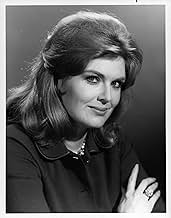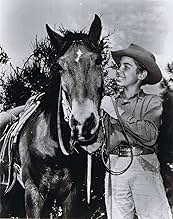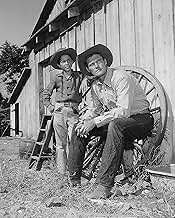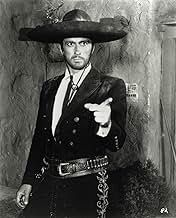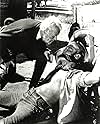Las aventuras de un ganadero del Salvaje Oeste, que tiene un rifle Winchester de disparo rápido personalizado, y su hijo.Las aventuras de un ganadero del Salvaje Oeste, que tiene un rifle Winchester de disparo rápido personalizado, y su hijo.Las aventuras de un ganadero del Salvaje Oeste, que tiene un rifle Winchester de disparo rápido personalizado, y su hijo.
- Nominado a 2 premios Primetime Emmy
- 3 nominaciones en total
Explorar episodios
Opiniones destacadas
10Jynne
As a kid growing up in the 70s, "The Rifleman" was one the only other western besides "Wild, Wild, West" that I really liked--I envied Mark McCain and the great father he had on the show (played by Connors). Yes, each show was a morality play but so were many other shows of the 50s & 60s (including "Star Trek"). They made their point at a time when there was still some innocence in America, and even taught tolerance for people from other countries/cultures (for example, in the episode of "Rifleman" where a Japanese man gets insulted & pushed into a fight with one of the locals & uses Judo to defend himself). Lucas McCain taught his son by example NEVER to use a gun or fight unless it was self-defense. It sounds silly now, but when I was a kid I wished my dad had explained things to me the same way Chuck Connors did to his son in the show--ah well, thank goodness for TV writers! :)
I am so pleased this marvelous "TV Noir" from the late 1950's is back on TV re-runs (Hallmark Channel). As a kid, I watched this show because I wanted a rifle like the one Lucas McCain had. As a 50+ year old now, I enjoy the show for a different reason - the very different style of filming it used - B&W of course, but dark, with high contrasts much like film noir. As a father of two sons I also like the interaction between father and son on the show, and how Mark is taught from "The good Book" as well as from experience, and Lucas teaches by example, hard lessons and easy ones, a stern but always loving father. The depiction of a simple life with hard work, long days, and well deserved rest at supper is perhaps fantasy in today's world, but good to strive for. Micah as a no-nonsense sheriff who has lost an edge to old age, and compensates by packing a sawed-off scatter-gun and common sense to keep the peace. No blood or gore, no entry and exit wounds, who cares? That's why I like this genre of TV, it's simple and plain, but sends a good message of hard work, simple life, and good overcomes evil in the end.
Chuck Connors showed more acting in this show than he did in any other, and seems to have been made for the part. Forget all the gibberish about guns and TV. I love this show, and other westerns, and have never owned a gun, nor do I plan to (unless I take up hunting). That's not the point. The point to me is the lessons taught in these shows, good overcomes evil in the end, and justice is served. Real life? No. But that's why I like to watch these shows - good overcomes evil at least for a Saturday afternoon.
This show, and a couple of others - Virginian and High Chaparral were some of the best TV viewing for me growing up. Emphasis on character building, the Western scenery was just window-dressing to me. Even Bonanza (after Michael Landon started to influence stories more) became a great show emphasizing character building. As a father, I learned from all the fathers in these shows (as well as from my own father) how to be a good father, and help to build good character in my own sons. Who said the TV was an "idiot box". Like a computer, it's a tool, and can be used for idiot purposes, or for growing.
Chuck Connors showed more acting in this show than he did in any other, and seems to have been made for the part. Forget all the gibberish about guns and TV. I love this show, and other westerns, and have never owned a gun, nor do I plan to (unless I take up hunting). That's not the point. The point to me is the lessons taught in these shows, good overcomes evil in the end, and justice is served. Real life? No. But that's why I like to watch these shows - good overcomes evil at least for a Saturday afternoon.
This show, and a couple of others - Virginian and High Chaparral were some of the best TV viewing for me growing up. Emphasis on character building, the Western scenery was just window-dressing to me. Even Bonanza (after Michael Landon started to influence stories more) became a great show emphasizing character building. As a father, I learned from all the fathers in these shows (as well as from my own father) how to be a good father, and help to build good character in my own sons. Who said the TV was an "idiot box". Like a computer, it's a tool, and can be used for idiot purposes, or for growing.
I don't know why they used a colorized photo to represent The Rifleman show on the video cover. If the video is colorized, that would be a good reason to not buy it. And I'm not particularly against colorized reprints. It's just that this show truly shined in its B&W mode.
As was demonstrated by Frankenheimer's The Train, a few cinematographers and directors reached a peak of artistic visual clarity during the late 50s-early 60s. This TV show was a good example of that artisanship. Such quality continues to be rare in TV production. You could say it's because TV production has always been a low-funded affair, but such fine art doesn't cost any more than the expensive stuff. What it takes is a highly talented cinematographer and director. That's the rarity, in both films and TV.
Viewers were certainly not jaded back then, nonetheless when a show aired on TV that was clearly well produced, in terms of b&w visual clarity, you can bet we uneducated viewers noticed it, if we weren't yet aware of why we were noticing it. The Rifleman was that kind of show. The screen of our old Zenith b&w console, not a high tech unit by any means, really lit up when this show came on. Like a musician who can take a shabby instrument and make it sing, this quality of production could somehow make our crummy old TV look better than it was worth. A real value, for free and on the air.
The opening sequence to every episode was exciting enough to suck any of us into the TV screen, with the camera dollying backwards in sinc with Connors moving forward repeatedly shooting/cocking his modified, cut-down rifle. No music yet. Nothing but bam, bam, bam, bam, bam, bam, bam, bam `The Rifleman' the seriously over-concerned voice-over would announce. We were hooked, and the western styled orchestral music would begin to play.
What is most striking as I vividly remember this shot now almost 40 years later, is the utter smoothness of Connor's walk and steady gaze as he moved forward step by slow step. I realize it is the exact same style of strong, silent type walk which Clint Eastwood was making a trademark. Funny to think that Connors, not a highly respected actor in circles, was doing this bit just as well as Eastwood did so many times later. Hey, if it works, work it. They had similar body types, and their plain, button-down western shirts fit in the same way. These were not the heavily muscled heroes today's boys are led to appreciate. They were tall, sinewy men, and it leant their characters a certain degree of intelligence along with the brawn.
Westerns were such a solid part of Hollywood movie studios' profit revenue, that's why artistic license was allowed the directors of these independently produced film/TV productions. Leave It to Beaver, believe it or not, was another great example of intelligent writing allowed into a stagnant arena of suburban styled family serials. Just check out the difference between Beaver and Dobie Gillis, as compared to Ozzie and Harriet and Gilligan's Island. The latter were undeniably stupid, one dimensional shows, while the former brought intelligent satire into play.
As I look back, a fatherless child at the time, Connors' brave good guy/bad guy characters really worked on me. This was where I managed to develop a diverse sense of humanity, because the directors and writers were allowed to make these characters and their stories somewhat multi-dimensional. The 60s was a great time, in terms of expanding a very innocent TV audience's view of the world outside our sheltered lives (there was never anything closely resembling CNN or Howard Stern, of course).
Two years after The Rifleman finished running there started a new Chuck Connors cowboy series called Branded. Where The Rifleman was certainly the most violently provocative show on TV, Branded was even more sadistic. As kids we ate it all up. In what is now understood to be a sort of Peckinpah tradition of graphic violence, these shows were the directors' training grounds for such sadistic style. They were really pushing the envelope of censorship. My mom used to get upset when we watched these shows.
As was demonstrated by Frankenheimer's The Train, a few cinematographers and directors reached a peak of artistic visual clarity during the late 50s-early 60s. This TV show was a good example of that artisanship. Such quality continues to be rare in TV production. You could say it's because TV production has always been a low-funded affair, but such fine art doesn't cost any more than the expensive stuff. What it takes is a highly talented cinematographer and director. That's the rarity, in both films and TV.
Viewers were certainly not jaded back then, nonetheless when a show aired on TV that was clearly well produced, in terms of b&w visual clarity, you can bet we uneducated viewers noticed it, if we weren't yet aware of why we were noticing it. The Rifleman was that kind of show. The screen of our old Zenith b&w console, not a high tech unit by any means, really lit up when this show came on. Like a musician who can take a shabby instrument and make it sing, this quality of production could somehow make our crummy old TV look better than it was worth. A real value, for free and on the air.
The opening sequence to every episode was exciting enough to suck any of us into the TV screen, with the camera dollying backwards in sinc with Connors moving forward repeatedly shooting/cocking his modified, cut-down rifle. No music yet. Nothing but bam, bam, bam, bam, bam, bam, bam, bam `The Rifleman' the seriously over-concerned voice-over would announce. We were hooked, and the western styled orchestral music would begin to play.
What is most striking as I vividly remember this shot now almost 40 years later, is the utter smoothness of Connor's walk and steady gaze as he moved forward step by slow step. I realize it is the exact same style of strong, silent type walk which Clint Eastwood was making a trademark. Funny to think that Connors, not a highly respected actor in circles, was doing this bit just as well as Eastwood did so many times later. Hey, if it works, work it. They had similar body types, and their plain, button-down western shirts fit in the same way. These were not the heavily muscled heroes today's boys are led to appreciate. They were tall, sinewy men, and it leant their characters a certain degree of intelligence along with the brawn.
Westerns were such a solid part of Hollywood movie studios' profit revenue, that's why artistic license was allowed the directors of these independently produced film/TV productions. Leave It to Beaver, believe it or not, was another great example of intelligent writing allowed into a stagnant arena of suburban styled family serials. Just check out the difference between Beaver and Dobie Gillis, as compared to Ozzie and Harriet and Gilligan's Island. The latter were undeniably stupid, one dimensional shows, while the former brought intelligent satire into play.
As I look back, a fatherless child at the time, Connors' brave good guy/bad guy characters really worked on me. This was where I managed to develop a diverse sense of humanity, because the directors and writers were allowed to make these characters and their stories somewhat multi-dimensional. The 60s was a great time, in terms of expanding a very innocent TV audience's view of the world outside our sheltered lives (there was never anything closely resembling CNN or Howard Stern, of course).
Two years after The Rifleman finished running there started a new Chuck Connors cowboy series called Branded. Where The Rifleman was certainly the most violently provocative show on TV, Branded was even more sadistic. As kids we ate it all up. In what is now understood to be a sort of Peckinpah tradition of graphic violence, these shows were the directors' training grounds for such sadistic style. They were really pushing the envelope of censorship. My mom used to get upset when we watched these shows.
Chuck Connors plays an inspiring hero in The Rifleman, defending himself, his son, and his friends against gunslingers, cheats, and swindlers. His character (Lucas McCain) is brilliant, brave, strong and just, and supported by a great cast. It's a beautiful series that I often find myself staying up way too late to watch.
I think much of the success of "The Rifleman" TV series was due to the casting of Chuck Connors as the "hero." We quickly grew used to him in this part but at the time the series started, he was probably regarded by many casting directors as a "bad guy" -- such as the part he played in "The Big Country." There was something mean and menacing about him. But by casting him as the boy's father in "The Rifleman," the show used Connors' toughness to counteract the sentimentality that might otherwise have enveloped this series. (Can you imagine how syrupy "The Rifleman" would have been had Doug McClure played the lead?)
¿Sabías que…?
- TriviaIn the pilot, originally written for La ley del revólver (1955), Chuck Connors' character was named John McCain, he had no children and he was a dead shot with a pistol. Arnold Laven decided to make McCain a widower with a son whose weapon of choice was a customized Winchester rifle.
- ErroresLucas McCain's rifle is a modified 1892 .44-40 Winchester, even though the series clearly establishes itself in the 1880s.
- Citas
[repeated line]
Mark McCain: Pa!
- ConexionesFeatured in The Movie Orgy (1968)
Selecciones populares
Inicia sesión para calificar y agrega a la lista de videos para obtener recomendaciones personalizadas
- How many seasons does The Rifleman have?Con tecnología de Alexa
Detalles
- Fecha de lanzamiento
- País de origen
- Sitio oficial
- Idioma
- También se conoce como
- The Rifleman
- Locaciones de filmación
- Productoras
- Ver más créditos de la compañía en IMDbPro
- Tiempo de ejecución30 minutos
- Color
- Relación de aspecto
- 4:3
Contribuir a esta página
Sugiere una edición o agrega el contenido que falta

Principales brechas de datos
What is the Japanese language plot outline for El hombre del rifle (1958)?
Responda

